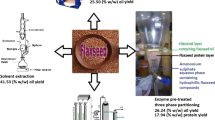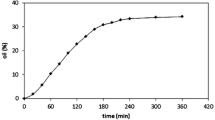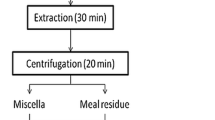Abstract
In this study, enzyme-assisted three-phase partitioning (EATPP) was used to extract oil from flaxseed. The whole procedure is composed of two parts: the enzymolysis procedure in which the flaxseed was hydrolyzed using an enzyme solution (the influencing parameters such as the type and concentration of enzyme, temperature, and pH were optimized) and three-phase partitioning (TPP), which was conducted by adding salt and t-butanol to the crude flaxseed slurry, resulting in the extraction of flaxseed oil into alcohol-rich upper phase. The concentration of t-butanol, concentration of salt, and the temperature were optimized to maximize the extraction yield. Under optimized conditions of a 49.29 % t-butanol concentration, 30.43 % ammonium sulfate concentration, and 35 °C extraction temperature, a maximum extraction yield of 71.68 % was obtained. This simple and effective EATPP can be used to achieve high extraction yields and oil quality, and thus, it is potential for large-scale oil production.




Similar content being viewed by others
References
Rizwan, S., Naqshbandi, A., Farooqui, Z., Khan, A. A., & Khan, F. (2014). Protective effect of dietary flaxseed oil on arsenic-induced nephrotoxicity and oxidative damage in rat kidney. Food and Chemical Toxicology, 68, 99–107.
Goyal, A., Sharma, V., Upadhyay, N., Gill, S., & Sihag, M. (2014). Flax and flaxseed oil: an ancient medicine & modern functional food. Journal of Food Science and Technology-Mysore, 51, 1633–1653.
Oomah, B. D. (2001). Flaxseed as a functional food source. Journal of the Science of Food and Agriculture, 81, 889–894.
Bozan, B., & Temelli, F. (2002). Supercritical CO2 extraction of flaxseed. Journal of the American Oil Chemists Society, 79, 231–235.
Gandhi, A., Joshi, K., Jha, K., Parihar, V., Srivastav, D., Raghunadh, P., Kawalkar, J., Jain, S., & Tripathi, R. (2003). Studies on alternative solvents for the extraction of oil‐I soybean. International Journal of Food Science and Technology, 38, 369–375.
Ferreira-Dias, S., Valente, D. G., & Abreu, J. M. (2003). Comparison between ethanol and hexane for oil extraction from Quercus suber L. fruits. Grasas Y Aceites, 54, 378–383.
Vidhate, G. S., & Singhal, R. S. (2013). Extraction of cocoa butter alternative from kokum (Garcinia indica) kernel by three phase partitioning. Journal of Food Engineering, 117, 464–466.
Yu, X., Deng, Q. C., Xu, J. Q., Huang, F. H., Huang, Q. D., Yin, Z. H., & Yang, J. N. (2012). Effects of cold-pressed and vitamin E-enriched flaxseed oils on lipid profile and antioxidant status in high-fat fed rats. European Journal of Lipid Science and Technology, 114, 461–468.
Khattab, R. Y., & Zeitoun, M. A. (2013). Quality evaluation of flaxseed oil obtained by different extraction techniques. LWT--Food Science and Technology, 53, 338–345.
Sharma, A., & Gupta, M. N. (2004). Oil extraction from almond, apricot and rice bran by three-phase partitioning after ultrasonication. European Journal of Lipid Science and Technology, 106, 183–186.
Li, Z., Jiang, F., Li, Y., Zhang, X., & Tan, T. (2013). Simultaneously concentrating and pretreating of microalgae Chlorella spp. by three-phase partitioning. Bioresource Technology, 149, 286–291.
Li, Z., Li, Y., Zhang, X., & Tan, T. (2015). Lipid extraction from non-broken and high water content microalgae Chlorella spp. by three-phase partitioning. Algal Research-Biomass Biofuels and Bioproducts, 10, 218–223.
Alvarez-Guerra, E., & Irabien, A. (2015). Ionic liquid-based three phase partitioning (ILTPP) systems for whey protein recovery: ionic liquid selection. Journal of Chemical Technology and Biotechnology, 90, 939–946.
Alvarez-Guerra, E., Irabien, A., Ventura, S. P. M., & Coutinho, J. A. P. (2014). Ionic liquid recovery alternatives in ionic liquid-based three-phase partitioning (ILTPP). Aiche Journal, 60, 3577–3586.
Kurmudle, N. N., Bankar, S. B., Bajaj, I. B., Bule, M. V., & Singhal, R. S. (2011). Enzyme-assisted three phase partitioning: a novel approach for extraction of turmeric oleoresin. Process Biochemistry, 46, 423–426.
Vetal, M. D., & Rathod, V. K. (2014). Three phase partitioning a novel technique for purification of peroxidase from orange peels (Citrus sinenses). Food and Bioproducts Processing, 94, 284–289.
Wang, H. H., Chen, C. L., Jeng, T. L., & Sung, J. M. (2011). Comparisons of alpha-amylase inhibitors from seeds of common bean mutants extracted through three phase partitioning. Food Chemistry, 128, 1066–1071.
Gagaoua, M., Hoggas, N., & Hafid, K. (2015). Three phase partitioning of zingibain, a milk-clotting enzyme from Zingiber officinale Roscoe rhizomes. International Journal of Biological Macromolecules, 73, 245–252.
Garg, R., & Thorat, B. N. (2014). Nattokinase purification by three phase partitioning and impact of t-butanol on freeze drying. Separation and Purification Technology, 131, 19–26.
Roy, I., & Gupta, M. N. (2002). Three-phase affinity partitioning of proteins. Analytical Biochemistry, 300, 11–14.
Sharma, A., & Gupta, M. N. (2001). Three phase partitioning as a large-scale separation method for purification of a wheat germ bifunctional protease/amylase inhibitor. Process Biochemistry, 37, 193–196.
Sharma, A., Sharma, S., & Gupta, M. N. (2000). Purification of alkaline phosphatase from chicken intestine by three-phase partitioning and use of phenyl-Sepharose 6B in the batch mode. Bioseparation, 9, 155–161.
Gaur, R., Sharma, A., Khare, S. K., & Gupta, M. N. (2007). A novel process for extraction of edible oils Enzyme assisted three phase partitioning (EATPP). Bioresource Technology, 98, 696–699.
Shah, S., Sharma, A., & Gupta, M. (2004). Extraction of oil from Jatropha curcas L. seed kernels by enzyme assisted three phase partitioning. Industrial Crops and Products, 20, 275–279.
Dutta, R., Sarkar, U., & Mukherjee, A. (2015). Process optimization for the extraction of oil from Crotalaria juncea using three phase partitioning. Industrial Crops and Products, 71, 89–96.
Jung, S., Maurer, D., & Johnson, L. (2009). Factors affecting emulsion stability and quality of oil recovered from enzyme-assisted aqueous extraction of soybeans. Bioresource Technology, 100, 5340–5347.
Pare, A., Nema, A., Singh, V. K., & Mandhyan, B. L. (2014). Combined effect of ohmic heating and enzyme assisted aqueous extraction process on soy oil recovery. Journal of Food Science and Technology-Mysore, 51, 1606–1611.
Gai, Q.-Y., Jiao, J., Wei, F.-Y., Luo, M., Wang, W., Zu, Y.-G., & Fu, Y.-J. (2013). Enzyme-assisted aqueous extraction of oil from Forsythia suspense seed and its physicochemical property and antioxidant activity. Industrial Crops and Products, 51, 274–278.
Jin, G., Yang, F., Hu, C., Shen, H., & Zhao, Z. K. (2012). Enzyme-assisted extraction of lipids directly from the culture of the oleaginous yeast Rhodosporidium toruloides. Bioresource Technology, 111, 378–382.
J-j, L., Y-j, F., Y-g, Z., Li, J., Wang, W., C-b, G., & Luo, M. (2011). Ultrasound-assisted extraction of flaxseed oil using immobilized enzymes. Bioresource Technology, 102, 9991–9996.
Zhang, S., Zu, Y.-G., Fu, Y.-J., Luo, M., Liu, W., Li, J., & Efferth, T. (2010). Supercritical carbon dioxide extraction of seed oil from yellow horn (Xanthoceras sorbifolia Bunge.) and its anti-oxidant activity. Bioresource Technology, 101, 2537–2544.
Gai, Q.-Y., Jiao, J., Mu, P.-S., Wang, W., Luo, M., Li, C.-Y., Zu, Y.-G., Wei, F.-Y., & Fu, Y.-J. (2013). Microwave-assisted aqueous enzymatic extraction of oil from Isatis indigotica seeds and its evaluation of physicochemical properties, fatty acid compositions and antioxidant activities. Industrial Crops and Products, 45, 303–311.
Dennison, C., & Lovrien, R. (1997). Three phase partitioning: concentration and purification of proteins. Protein Expression and Purification, 11, 149–161.
Harde, S. M., & Singhal, R. S. (2012). Extraction of forskolin from Coleus forskohlii roots using three phase partitioning. Separation and Purification Technology, 96, 20–25.
Tan, Z.-J., Wang, C.-Y., Yi, Y.-J., Wang, H.-Y., Zhou, W.-L., Tan, S.-Y., & Li, F.-F. (2015). Three phase partitioning for simultaneous purification of aloe polysaccharide and protein using a single-step extraction. Process Biochemistry, 50, 482–486.
Aysu, Ş., Melike, E., Bayraktar, H., & Seçil, Ö. (2011). Purification of α-galactosidase from pepino (Solanum muricatum) by three-phase partitioning. Separation and Purification Technology, 83, 130–136.
Shanmugaprakash, M., Jayashree, C., Vinothkumar, V., Senthilkumar, S., Siddiqui, S., Rawat, V., & Arshad, M. (2015). Biochemical characterization and antitumor activity of three phase partitioned l-asparaginase from Capsicum annuum L. Separation and Purification Technology, 142, 258–267.
Mulchandani, K., Kar, J. R., & Singhal, R. S. (2015). Extraction of lipids from Chlorella saccharophila using high-pressure homogenization followed by three phase partitioning. Applied Biochemistry and Biotechnology, 176, 1613–1626.
Acknowledgments
This work was financially supported by the National Natural Science Foundation of China (21406262) and the Agricultural Science and Technology Innovation Program (ASTIP-IBFC07).
Author information
Authors and Affiliations
Corresponding authors
Rights and permissions
About this article
Cite this article
Tan, Zj., Yang, Zz., Yi, Yj. et al. Extraction of Oil from Flaxseed (Linum usitatissimum L.) Using Enzyme-Assisted Three-Phase Partitioning. Appl Biochem Biotechnol 179, 1325–1335 (2016). https://doi.org/10.1007/s12010-016-2068-x
Received:
Accepted:
Published:
Issue Date:
DOI: https://doi.org/10.1007/s12010-016-2068-x




